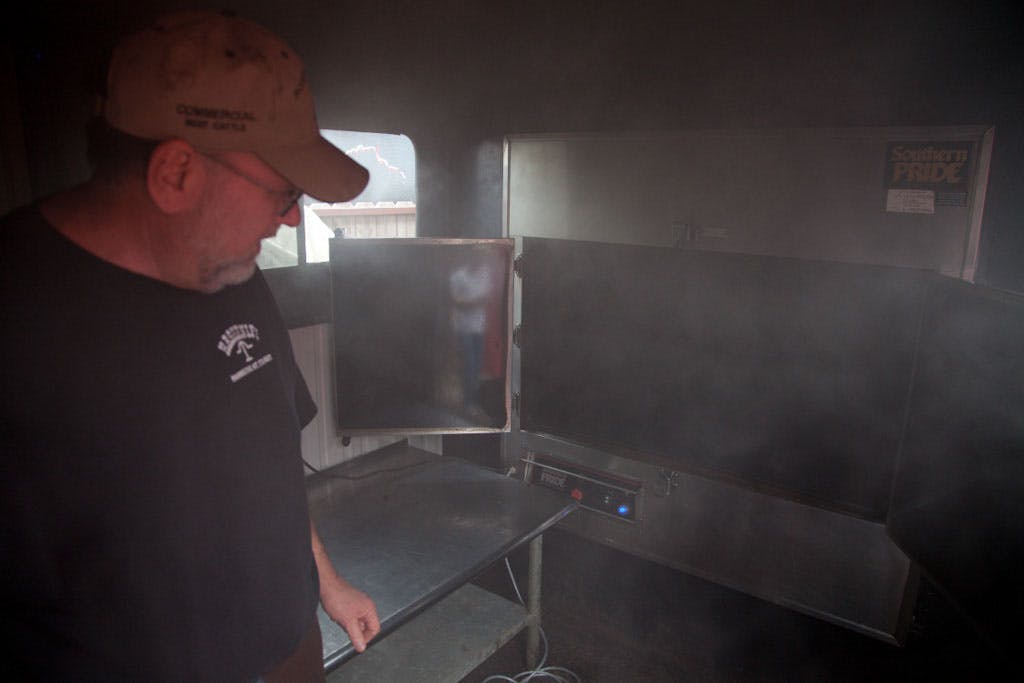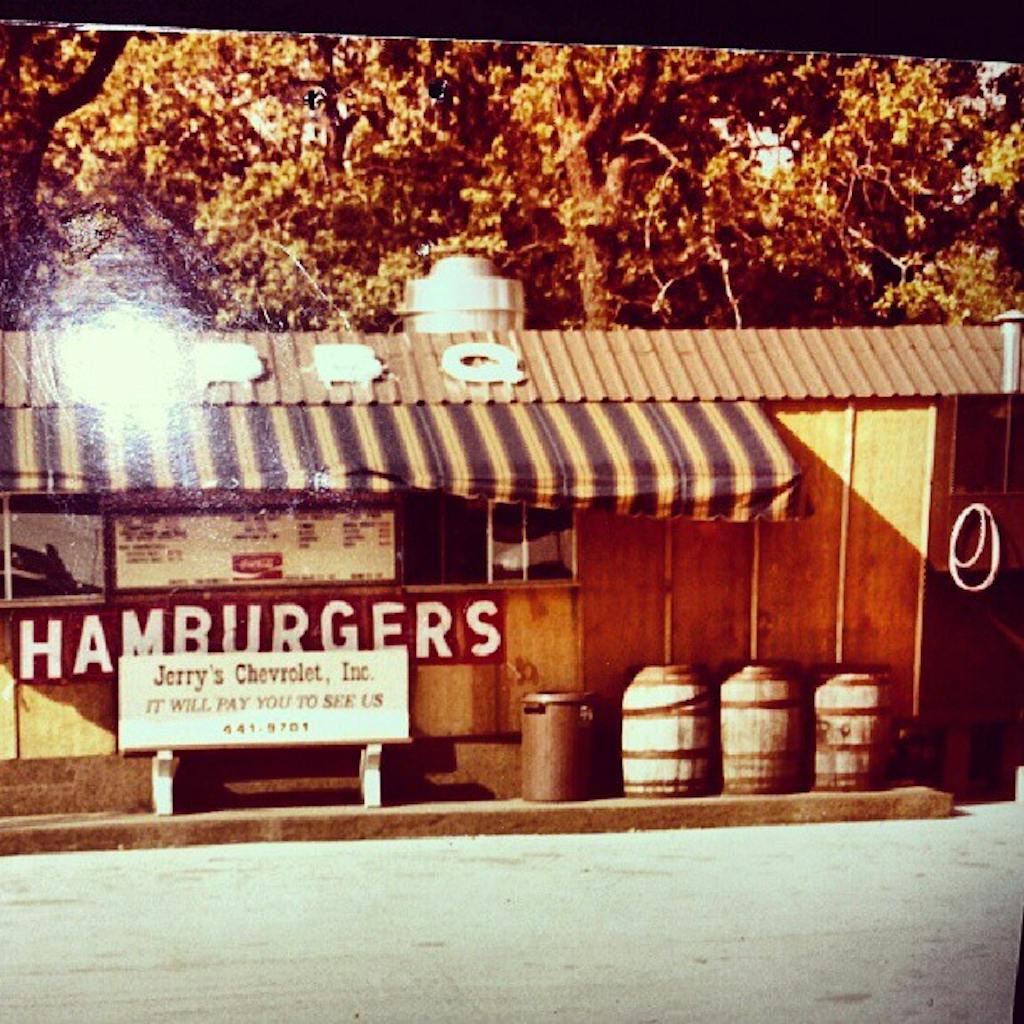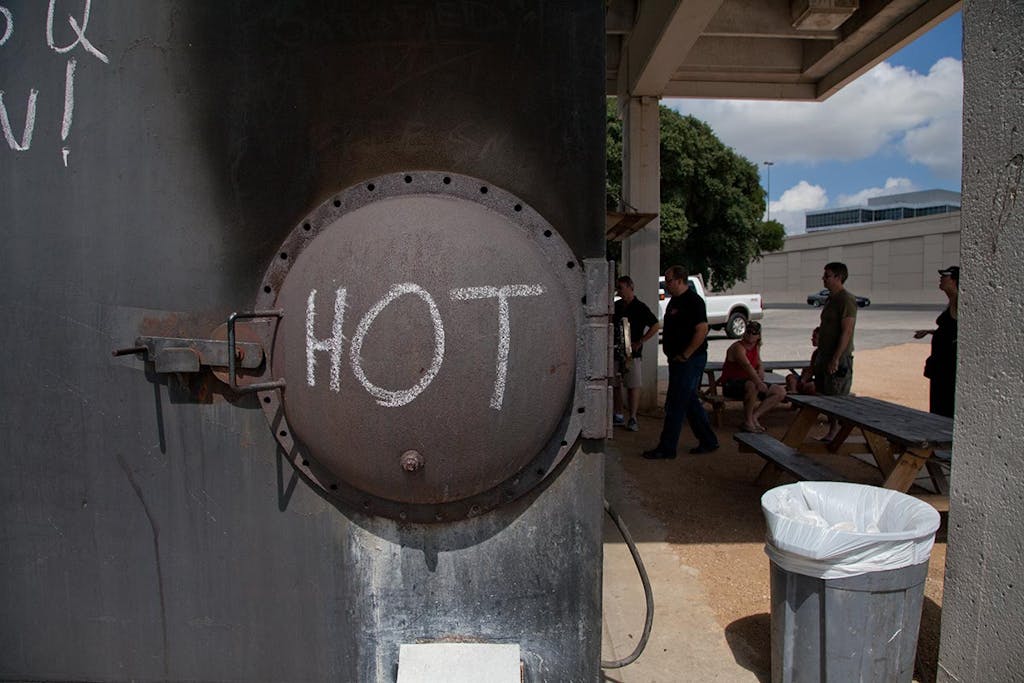
Owner/Pitmaster: Hashknife on the Chisholm, opened 2006
Age: 51
Smoker: Gas-fired Rotisserie Smoker
Wood: Oak and pecan
Jim McLennan and his wife have run a barbecue joint at the southwest corner of highways 281 and 284 for over a decade. Shortly after he bought the place in 2005 he also bought the house next door. He’s lived in this area of the state most of his life and graduated from Weatherford High School. In all his time living in the area, Big Jim never saw another business last more than two years in his current location, but he’s been going for seven. That longevity was tested earlier this year when he and his wife closed the place and put it up for sale. It looked like Hashknife on the Chisholm might be gone for good, but the McLennans opened just three weeks later.
Daniel Vaughn: So you just got back from a trip?
Jim McLennan: Yeah. We just got back from San Antone.
DV: What were you doing down there?
JM: I always wanted to stay at the Menger Hotel because my uncle had stayed there for years and years. My wife had a hair show down there so we went.
DV: Did you get any pointers on new hairstyles for yourself?
JM: Oh yeah. [laughing] I have a lot to work with.
DV: I noticed online that you visited the Smoke Shack in San Antonio. Did you go there to try some new barbecue?
JM: We had a nice visit. I gave him a photo of my first barbecue trailer that I built with Tommy Smith for Tommy’s Hamburgers in Lake Worth. We built a big pit on the trailer and did hamburgers and barbecue. It was my first commercial barbecue place.

DV: What was the significance of the photo?
JM: After Tommy sold that trailer to move into a store it went over to a guy at Benbrook Lake. Then this guy [Chris Conger of the Smoke Shack] bought it. By the time he got it all the wood was torn off the sides. He completely redid it except for the pit.
DV: When was that trailer built?
JM: It was ’81 or ’82. I can’t remember so far back.
DV: Wow. So the Smoke Shack in San Antonio is using the pit you built thirty years ago in Lake Worth. How did you know they were using it?
JM: I saw the guys on the internet. Some of your friends went and ate down there and I saw their picture of it. I said “That’s my old pit.” I couldn’t miss it because of the rung on the back of it and the two holes that were on the firebox. I knew where that came from.
DV: Did you imagine that this old pit was still being used by someone?
JM: You know, I didn’t. The last time I saw it, it was over by Benbrook Lake.
DV: That’s some coincidence.
JM: It was crazy, man. I couldn’t wait to go make sure that was it, but I just knew it was. There’s no other firebox door like it.
DV: I guess it pays to build in those signatures into your pit design.
JM: That’s just what we had at the time to use. It was an old boiler lid that had about thirty holes all the way around it.

DV: The pit’s still around, but is Tommy’s?
JM: Tommy sold out, but there’s one on Camp Bowie and a new one just opened up on Forest Park.
DV: Was Tommy’s your first experience in barbecue?
JM: No. I had my first pit in ’79. I cooked around Weatherford for ranches doing mostly game cooking. Then I went to Colorado and Oklahoma doing barbecue cook-offs. This was before all the barbecue craze. It was the late 70’s and on into the 90’s. This was back when it was just local.
DV: Were you winning enough of the cook-offs to make a living?
JM: There wasn’t any money in it back then. Bragging rights and trophies is all there ever was until these big competitions came along. Even in the ‘90’s there wasn’t enough money to even buy your gas.
DV: What made you want to drive all over the country cooking?
JM: We were wild and crazy back then. We went up to Lake City, Colorado on the Fourth of July one time and served thirty cases of briskets one weekend. I had one pit and one other guy helping me. I had a mad old man up there from Tubb’s Barbecue. He threatened to blow up my pit. He raised so much hell we couldn’t even make the donation to the local fire department we were planning. We came home with an awful lot of money after that weekend.
DV: He was just mad that you took away his business?
JM: Yes. His crock-pot barbecue business, anyway.
DV: Did you go straight from the barbecue circuit to your joint in Peadenville, Texas.
JM: I worked for a while at the first Railhead down on the train tracks back when Harry [Pilcher] took it over after he left Angelo’s. I took a little break after I moved out of there, but I always catered. I went up to Possum Kingdom where I was a striper guide for several years while I worked at a restaurant called Scenic Point. I catered at the oil fields too. I did about three hundred fracks a year from 1999-2006. It was always about 200 people a day for five or six days a week. I did all the cooking on site.
DV: Was it always barbecue?
JM: No. I cooked just like their grandmother would. That’s no joke. I had them so fat I had their wives pissed off at me. I cooked chicken fries, pork chops, everything.
DV: You’re a man of many cooking talents.
JM: That’s right. I can cook about anything that people like and make it taste pretty dang good.
DV: I hear that Cajun cooking is now one of those specialties.
JM: Yes. I went down to New Orleans in the famed Poppy Tooker’s kitchen. She’s the one that beat Bobby Flay’s a– in the gumbo throwdown. I cooked with her for four days and learned some gumbo and we brought it back to Peadenville. We do that on Thursdays in the winter. I love barbecue, but there’s a lot of other things that I like to cook. We also do dirty rice. It’s a wet dirty rice, not like that dry stuff in Fort Worth that you need a glass of water to eat it with. Not this stuff, baby. You can put it on a piece of white bread and eat it the next day for lunch. It’s some of the best dirty rice you’ll ever eat.
DV: I’d imagine being out there away from any other restaurant options that your regulars appreciate the options.
JM: I could not have made it out here without throwing something else on the menu. The people around here can’t eat barbecue but once a week at the most.
DV: How did you arrive at that particular location?
JM: When the barbecue places all closed in Mineral Wells I went into town looking to open a place. Every property I found, the city wanted me to rip out half the parking and plant cactus and flowers. I told them “Forget it.” I ran into this guy one day who owned this corner. I asked him if he wanted to sell it. He said “I’ll call you on April 7th, 2005.” That was like a year away, but he called me. I’d forgotten about it, but he said “You can have that corner if you want it, Jim.”
DV: What did you tell him?
JM: I said “Hell yes, I still want it.” I had the equipment to put in it. As far as people coming, I just didn’t know. The folks in the oil field knew my food.
DV: What was it about that corner way out there that drew you to it?
JM: It’s right there along 281 at a four way stop. There are a lot of trucks trying to stay off I-35, there are a lot of cutting horse people out here too. It’s growing around here too. There’s nowhere to grow out of Weatherford except west if you want any land at all. I also get all my PK [Possum Kingdom] lake people around here in the summer.
DV: I’ve got to tell you that Hashknife on the Chisholm is the coolest barbecue joint name in the state. Where did the name come from?
JM: Well I appreciate that. That’s my great grandfather’s cattle brand from the 1800’s on the old Hashknife Ranch. He and two other ranches along with two railroad men founded the town of Abilene, Texas.

DV: What was your great grandfather’s name?
JM: John N. Simpson. He was also the president of the State Fair of Texas and a few other things.
DV: Is he the one on the historical marker in Abilene?
JM: Yes. The main house is still there. It’s a bed and breakfast, but it was his headquarters.
An excerpt from that historical marker: “In December 1880, HC Withers of the Texas & Pacific Railroad met local men here to decide on a site for a cattle shipping center. Bypassing the county seat of Buffalo Gap, the railroad platted a new town named Abilene for the famous cattle town in Kansas. Cattlemen meeting with Weathers were Dallas Baker and Hashknife Ranch co-owner John N. Simpson, and Confederate Colonels Claiborne W. (Clabe) and JD Merchant, twin brothers and ranchers who moved to Callahan County six years earlier.”
DV: What about the Chisholm part of the name?
JM: They say that the main route of the Chisholm Trail went through Fort Worth, but there were so many branches. We’re right here in an area known for cattle pioneers.
DV: Is the Hashknife brand still used?
JM: It’s still a running brand around the Throckmorton County area. Ernie Hunt has the Hashknife brand now. His dad had it before him. The Babbett Brothers got the Hashknife brand in Arizona. They’ve got a big place that been going for more than a hundred years. I like to research history like that. I think I was born in the wrong era.
DV: Well, there’s some history there in Peadenville, right?
JM: Yes. The Goodnight Loving Trail started here. Loving’s old home was just a half mile from here. In fact I used a metal detector to find the old Loving well out at his place. Oren is just right down the road too where the Goodnight Loving Trail started. We’ve got some history here, just not a lot of people.
DV: This is the second time you’ve made it on the Texas Monthly Top 50. Are more people finding you on this go ‘round?
JM: This is a destination place. Ninety percent of my business is people coming out of Weatherford, Jacksboro and Fort Worth. They come mainly for my ribs. I’ve improved my brisket with a new rub. Even though I’m a gasser, I can do a good brisket.
DV: So you call yourself a gasser, huh?
JM: You bet. I’m a gasser. I believe you came up with that term. I built over twenty wood burning pits, but I just can’t do it anymore. I also think gassers are better than people give them credit for, you just need to know how to use them.
DV: How do you properly use a gas-fired smoker?
JM: More wood. I cook with a little more heat than most people would. I come in and turn it up in the morning so I can smell that fat cooking. I think they cook some of the best ribs, and they’re right every time. People say you’re lazy for using them, but having a product that’s right every time is what it’s about.
DV: I don’t think anyone would call you lazy.
JM: I wouldn’t either. I work fourteen hours a day. We had to close for three weeks at the start of the summer. My wife got sick and we got wore out after the Texas Monthly deal came out. We didn’t have any help and I’ve already gotten a new hip from this restaurant. I’m just an old wounded cook.
DV: Was the three week vacation enough?
JM: Well, two weeks into it we came in and redid the whole kitchen. If I was going to open back up we were going to have air conditioning in the kitchen. Now it’s cooler in the kitchen than the dining room.
DV: So you think that’s enough to keep you going for a while?
JM: It helps all us old folks back here. There isn’t anyone under fifty in the kitchen. We trained three cooks from scratch. They’d never worked in a kitchen in their life. I’d rather train them my way anyway.
DV: Is the new staff just to keep up the status quo, or has there been an increase in business since the Top 50 was released?
JM: I’ve seen an increase. A lot of people call to get our hours. It’s helped us. I talk to all that I can. If they see the sign while they’re driving by they remember it because of the name and they stop.
DV: What else besides the barbecue is popular on the menu with travelers?
JM: Our burgers have really taken us over the top in Peadenville. I’m not going to just brag on the barbecue. We’ve got some of the best burgers out there. We grind our own meat. We don’t do all the fancy stuff like Rodeo Goat [in Fort Worth] and all them, but I’m gonna tell you something – we got some burgers.
DV: What are you grinding into the mix?
JM: Brisket. You don’t need anything else. It’s the best tasting hamburger meat in the world.
DV: I assume given your location that it’s gamble every day when trying to determine how much barbecue to cook. How unpredictable is it?
JM: Actually, I know the days pretty well. Wednesdays and Thursdays are mediocre. Fridays and Saturdays kick my a–. That’s the way it runs.
DV: So it’s more predictable than I assumed.
JM: We’ve been out here for eight years. I can tell how busy we’ll be by the amount of cars I pass when I come in in the morning. You also never know when a catering order will come in. We sometimes have an order for thirty or forty people at 10:30 in the morning. That can wipe out your supply, but I’ve been cooking two batches every day recently. On the weekends I’ve been going through a lot of ribs and brisket and even pork.

DV: Which if those, if any, do you consider your specialty?
JM: Ribs. I wish that’s all I cooked. I love cooking ribs. That’s what I started cooking in my driveway in Weatherford. I just love cooking ribs.
DV: What kind of ribs do you prefer?
JM: I cook spare ribs, but I trim then down to St. Louis ribs myself.
DV: What do you do with the rib tips?
JM: I sell them by the hundreds of pounds. I have a guy who comes in here and buys forty or fifty pounds at a time. He’ll buy whatever I have. He comes all the way from Burleson. I’ll freeze a bunch and save them for him.
DV: What’s he doing with them?
JM: I don’t care what he does with them. He may resell them. I don’t care as long as he gives me the money for them.
DV: Do you ever eat anyone else’s barbecue?
JM: Very seldom. I have lap-band so I can’t eat much barbecue. I’ll take a taste like I did down in San Antonio. I’ll try everybody’s ribs. I usually just go into Fort Worth and eat at Enchiladas Ole and Benito’s. I couldn’t do without Benito’s. It’s my number one spot.
DV: What’s next for Hashknife? Are you just going to see how long you can hold out?
JM: That’s the truth. I’ve got some help, but I still have to be here every day. I live about a hundred feet from here, but I’m waiting on some youngster to come up here and by me out. That way Big Jim can go down to LBJ Lake like I want to.
DV: Will you do any barbecue in your retirement?
JM: I’ll always have my catering trailer. I won’t ever quit cooking. I love to cook anything. Well, anything with meat.
DV: I’m glad to hear that your pit will still be fired up no matter where you go.
JM: I’ve been firing it up since 1979. I just made it easier on myself and I think we’re going to see a lot more gassers coming along.
DV: I guess if that’s what it takes to keep some of the old-timers going, then why not?
JM: When they’re young like the guys down in Austin those stick burners are fine, but when they get old they’ll start scratching their heads saying “Damn, there’s got to be something better than this.” I can’t wait until the day they turn fifty. But maybe they’re smarter than me and they’ll have somebody doing this s— for them.







